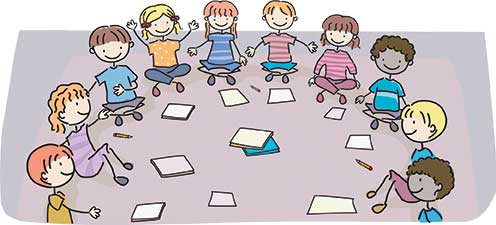Meena Sriram
Classrooms by and large have many challenges thrown at the adult on a daily basis. How many times have teachers found badly kept classrooms? Lunch or snack boxes left open on the desk even after the break, smelly shoes and socks after a PE session? Are these not scenes that most teachers relate to? Depending on the age of the class we also have children complaining about missing lunch boxes, notebooks and the like. There are also tantrums by kids and teenagers alike, exhibited in their age associated ways! Losing or winning a match on the ground surely has repercussions in the classroom and the minds of the students. What does all this boil down to? Maintaining equilibrium in a class of 40 or more children is a daunting task. How can teachers ensure that their classes run smoothly?
By forming circles! If a group of students has to work as one unit, look out for and understand each other, then circle time is an interesting strategy that teachers can adopt. When people sit in a circle, each member is visible to the others in the circle and since circles don’t have edges or corners, nobody can hide, giving the teacher the chance to include every member in the discussion. Thus, curative or restorative circles are a great way not just to bond but also to enable collective decision-making and problem solving.
Quality Circle Time (QCT) has proved successful in promoting better relationships and helps with positive behaviour management – two of the most essential requirements for learning and the smooth and harmonious running of a school*.
Using a restorative circle in the classroom will assist in building or restoring relationships among classmates. These circles could also be used to address wrongdoing, share joy and happiness, help plan and organize events, or prepare for unpredictable situations. Circles strengthen support systems and create trusting spaces.
Circles can be used:
• Every morning so the teachers can greet the children and gently warm up for the day.
• Every evening or at close of school to conclude the day and remind children of necessary matters for the next day.
• To frame ground rules and consequences.
• In the event of behavioural challenges.
• To celebrate festivals, achievements of members, happiness, or the like.
• In the event of a calamity either approaching or already existing.
• To organize group events like open day or annual day.
• Inviting a guest to share some information.

The list could go on and it is for each of us to use our ingenuity in adopting this technique on a regular basis while working with children.
Some children speak their hearts out, but some have difficulty in expressing their thoughts either for lack of vocabulary or lack of courage to speak up. Circles restore balance in the heads and hearts of the children and give confidence to the weakest to share their thoughts. The circle also engages the rest of the group to accept differences and stay away from forming judgements.
Undoubtedly circles require moderators to maintain harmony till the end. This requires a great amount of poise and patience and only then can circles be successful.
Teachers can begin conducting circle talks in a generic way and slowly master the art of handling focussed sessions. All one needs to keep in mind during these sessions is that every individual is involved.
There is really no age limit for participating in a circle time. It could be a restorative practice for children or adults too. For instance, when the parents of a particular class need to meet and address issues or challenges with the school, it could be done in a circle. The class teacher could take the lead to conduct the session. She can begin with a warm welcome to all the members in the circle and follow this up with a round of introductions. The class teacher can then encourage the parents to present their grievances or challenges. Surely there will be a number of parents who may want to either add to a point or differ. It is important that all the members feel free to express themselves without being judged. The role of the Class teacher or the conductor of the circle time is to remain patient and calm and listen to all.
In summary, a circle meet can be utilized as an effective tool to manage crises, or celebrate joy, or find solutions, or empathize with each other. Circles can be used to curate ideas or strengthen bonds. They could also be used to brainstorm like a bunch of 12 years old did in a certain school to decide how to run the shop where the produce from their farm could be sold. These young children discussed how to display farm produce and how to wrap the produce in an organic manner without using plastic. They went on to device the methodology of not just the shop but also about taking stock and refreshing produce periodically. Job allotment schedules were prepared and guidelines of hygiene were also insisted and charted during the circle time.
Circle time is not a closed group of people with different needs and anxieties, but an open strategy that allows you to accept everyone with all their differences and run your classrooms smoothly.
*https://www.circle-time.co.uk/our-approach/quality-circle-time/
The author is the academic administrator with the Chinmaya Education Cell and has about 28 years of teaching experience working with all age groups. She can be reached at meenasriram@gmail.com.
